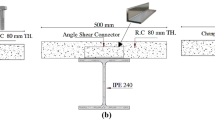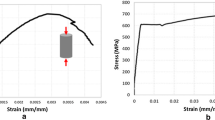Abstract
Strain-hardening cementitious composite (SHCC) was widely recognized as a material that possesses great potential in the repair and strengthening of reinforced concrete (RC) structures. SHCC can usually achieve high ductility with multiple cracking behavior and it also has excellent durability. Moreover, high tensile strength can also be achieved with proper mix design. In this study, conventional RC beams with shear span-to-depth ratio of 1.5:1 and 2.5:1 were cast first, while high-strength SHCC were then cast as thin patches on lateral surfaces of the RC beams to serve as the strengthening layers. The beams were subject to four-point bending test to obtain their ultimate shear capacities. It was observed from the test results that the ultimate shear capacity of strengthened RC beams increases evidently compared to the reference beams. Upon ultimate shear failure, no spalling of surface concrete occurred as it was restrained by the strengthening layers with the formation of stable multiple fine cracks. A finite element model was constructed to simulate the experimental tests. The results of FEM analysis correlated well with experimental results. A numerical parametric study was then carried out to evaluate the influence of the thickness of HS-SHCC layer and the shear span-to-depth ratio. This study concludes the feasibility of the use of high strength SHCC in shear strengthening of RC structures.












Similar content being viewed by others
References
Li VC, Horii H, Kabele P, Kanda T, Lim YM (2000) Repair and retrofit with engineered cementitious composites. Eng Fract Mech 65(2):317–334
Martinola G, Meda A, Plizzari GA, Rinaldi Z (2010) Strengthening and repair of RC beams with fiber reinforced concrete. Cement Concr Compos 32(9):731–739
Chen JF, Teng JG (2003) Shear capacity of FRP-strengthened RC beams: FRP debonding. Constr Build Mater 17(1):27–41
Li VC, Leung CKY (1992) Steady-state and multiple cracking of short random fiber composites. J Eng Mech 118(11):2246–2264
Li VC (1993) From micromechanics to structural engineering-the design of cementitous composites for civil engineering applications. J Struct Mech Earthq Eng JSCE 10:37–48
Li VC, Mishra DK, Wu HC (1995) Matrix design for pseudo strain-hardening fiber reinforced cementitious composites. Mater Struct 28(10):586–595
Li VC, Wang SX, Wu C (2001) Tensile strain-hardening behavior or polyvinyl alcohol engineered cementitious composite (PVA-ECC). ACI Mater J 98(6):483–492
Van Zijl GP, Wittmann FH (2011) Durability of strain-hardening fibre-reinforced cement-based composites (SHCC). Springer, Netherlands
Shin SK, Kim JJH, Lim YM (2007) Investigation of the strengthening effect of DFRCC applied to plain concrete beams. Cem Concr Compos 29(6):465–473
Kamal A, Kunieda M, Ueda N, Nakamura H (2008) Evaluation of crack opening performance of a repair material with strain hardening behavior. Cem Concr Compos 30(10):863–871
Hussein M, Kunieda M, Nakamura H (2012) Strength and ductility of RC beams strengthened with steel-reinforced strain hardening cementitious composites. Cem Concr Compos 34(9):1061–1066
Lim YM, Li VC (1997) Durable repair of aged infrastructures using trapping mechanism of engineered cementitious composites. Cem Concr Compos 19(4):373–385
Kabele P, Li VC, Horii H, Kanda T, Takeuchi S (1997) Use of BMC for ductile structural members. In: Proceedings of 5th international symposium on brittle matrix composite, Warsaw, Poland
Rokugo K, Kunieda M, Lim SC (2005) Patching repair with ECC on cracked concrete surface. In: Proceedings of ConMat05, Vancouver, Canada
Rokugo K, Kanda T, Yokota H, Sakata N (2009) Applications and recommendations of high performance fiber reinforced cement composites with multiple fine cracking (HPFRCC) in Japan. Mater Struct 42(9):1197–1208
Ranade R, Li VC, Stults MD, Heard WF, Rushing TS (2013) Composite properties of high-strength, high-ductility concrete. ACI Mater J 110(4):413–422
He S, Qiu J, Li J, Yang EH (2017) Strain hardening ultra-high performance concrete (SHUHPC) incorporating CNF-coated polyethylene fibers. Cem Concr Res 98:50–60
Yu KQ, Yu JT, Dai JG, Lu ZD, Shah SP (2018) Development of ultra-high performance engineered cementitious composites using polyethylene (PE) fibers. Constr Build Mater 158:217–227
Chen Y, Yu J, Leung CKY (2018) Use of high strength Strain-Hardening Cementitious Composites for flexural repair of concrete structures with significant steel corrosion. Constr Build Mater 167:325–337
Li VC, Mishra DK, Naaman AE, Wight JK, LaFave JM, Wu HC, Inada Y (1994) On the shear behavior of engineered cementitious composites. Adv Cem Based Mater 1(3):142–149
Kanda T, Lin Z, Li VC (1998) Application of pseudo strain-hardening cementitious composites to shear resistant structural elements. In: Fracture mechanics of concrete structures, Proceedings FRAMCOS-3, Freiburg, Germany
Shimizu K, Kanakubo T, Kanda T, Nagai S (2004) Shear behavior of steel reinforced PVA-ECC beams. In: 13th world conference on earthquake engineering, conference proceedings, Vancouver, Canada
Van Zijl GP (2007) Improved mechanical performance: shear behaviour of strain-hardening cement-based composites (SHCC). Cem Concr Res 37(8):1241–1247
Alyousif A, Anil O, Sahmaran M, Lachemi M, Yildirim G, Ashour AF (2016) Comparison of shear behaviour of engineered cementitious composite and normal concrete beams with different shear span lengths. Mag Concr Res 68(5):217–228
Alrefaei Y, Rahal K, Maalej M (2017) Shear strength of beams made using hybrid fiber–engineered cementitious composites. J Struct Eng 144(1):04017177
Yang X, Dai J, Lu Z (2017) Shear behaviour of RC beams strengthened with FRP grid reinforced engineered cementitious composites. In: APFIS2017—6th Asia-Pacific conference on FRP in structures, conference proceedings, Singapore
Wang G, Yang C, Pan Y, Zhu F, Jin K, Li K, Nanni A (2019) Shear behaviors of RC beams externally strengthened with engineered cementitious composite layers. Materials 12(13):2163
Kong FK, Evans RH (2017) Reinforced and prestressed concrete. CRC Press, Boca Raton
Wu C, Leung CKY, Li VC (2018) Derivation of crack bridging stresses in engineered cementitious composites under combined opening and shear displacements. Cem Concr Res 107:253–263
ABAQUS/Standard Analysis User’s Manual (2014)
Scott BD, Park R, Priestley MJN (1982) Stress–strain behavior of concrete confined by overlapping hoops at low and high strain rates. ACI J 79(1):13–27
Ren W, Sneed LH, Yang Y, He R (2015) Numerical simulation of prestressed precast concrete bridge deck panels using damage plasticity model. Int J Concr Struct Mater 9(1):45–54
Barth KE, Wu H (2006) Efficient nonlinear finite element modeling of slab on steel stringer bridges. Finite Elem Anal Des 42(14–15):1304–1313
Zhu HG, Leung CKY, Cao Q (2011) Preliminary study on the bond properties of the PDCC concrete repair system. J Mater Civ Eng 23(9):1360–1364
Sahmaran M, Yücel HE, Yildirim G, Al-Emam M, Lachemi M (2013) Investigation of the bond between concrete substrate and ECC overlays. J Mater Civ Eng 26(1):167–174
Momayez A, Ehsani MR, Ramezanianpour AA, Rajaie H (2005) Comparison of methods for evaluating bond strength between concrete substrate and repair materials. Cem Concr Res 35(4):748–757
Qian J, You C, Wang Q, Wang H, Jia X (2014) A method for assessing bond performance of cement-based repair materials. Constr Build Mater 68:307–313
Acknowledgements
The support of this study by the Hong Kong Research Grant Council through the General Research Fund (Grant Number: 16211617) is gratefully acknowledged. The third author would also like to acknowledge the support of his study by the Hong Kong PhD Fellowship.
Author information
Authors and Affiliations
Corresponding author
Ethics declarations
Conflict of interest
The authors declare that they have no conflict of interest.
Additional information
Publisher's Note
Springer Nature remains neutral with regard to jurisdictional claims in published maps and institutional affiliations.
Rights and permissions
About this article
Cite this article
Wei, J., Wu, C., Chen, Y. et al. Shear strengthening of reinforced concrete beams with high strength strain-hardening cementitious composites (HS-SHCC). Mater Struct 53, 102 (2020). https://doi.org/10.1617/s11527-020-01537-1
Received:
Accepted:
Published:
DOI: https://doi.org/10.1617/s11527-020-01537-1




